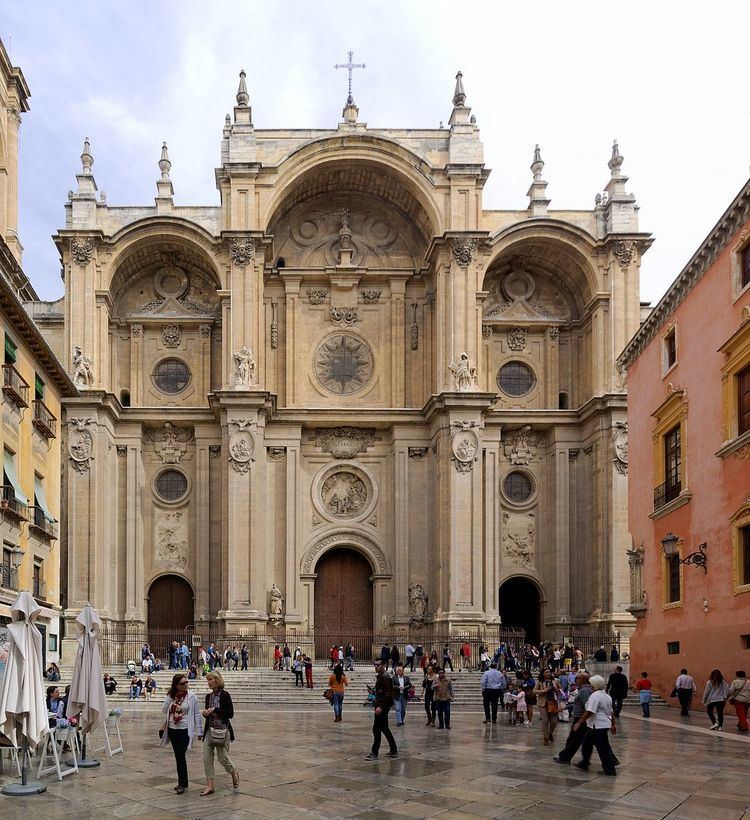Rite Roman | District Archdiocese of Granada Architectural type Church Phone +34 958 22 29 59 | |
 | ||
Address Calle Gran Vía de Colón, 5, 18001 Granada, Spain Architects Diego Siloe, Enrique de Egas, Felipe Bigarny, Juan Gil de Hontañón Similar Royal Chapel of Granada, Generalife, Granada Science Park, Carrera del Darro, Alhambra | ||
Granada cathedral catedral de granada
Granada Cathedral, or the Cathedral of the Incarnation (Spanish: Catedral de Granada, Santa Iglesia Catedral Metropolitana de la Encarnación de Granada) is a Roman Catholic church in the city of Granada, capital of the province of the same name in the Autonomous Region of Andalusia, Spain. The cathedral is the seat of the Archdiocese of Granada.
Contents
- Granada cathedral catedral de granada
- Granada cathedral and royal chapel outside and in
- History
- Features
- References
Granada cathedral and royal chapel outside and in
History
Unlike most cathedrals in Spain, construction of this cathedral had to await the acquisition of the Nasrid kingdom of Granada from its Muslim rulers in 1492; while its very early plans had Gothic designs, such as are evident in the Royal Chapel of Granada by Enrique Egas, the construction of the church in the main occurred at a time when Spanish Renaissance designs were supplanting the Gothic regnant in Spanish architecture of prior centuries. Foundations for the church were laid by the architect Egas starting from 1518 to 1523 atop the site of the city's main mosque; by 1529, Egas was replaced by Diego de Siloé who labored for nearly four decades on the structure from ground to cornice, planning the triforium and five naves instead of the usual three. Most unusually, he created a circular capilla mayor rather than a semicircular apse, perhaps inspired by Italian ideas for circular 'perfect buildings' (e.g. in Alberti's works). Within its structure the cathedral combines other orders of architecture. It took 181 years for the cathedral to be built.
Subsequent architects included Juan de Maena (1563-1571), followed by Juan de Orea (1571-1590), and Ambrosio de Vico (1590-?). In 1667 Alonso Cano, working with Gaspar de la Peña, altered the initial plan for the main façade, introducing Baroque elements. The magnificence of the building would be even greater, if the two large 81 meter towers foreseen in the plans had been built; however the project remained incomplete for various reasons, among them, financial.
The Cathedral had been intended to become the royal mausoleum by Charles I of Spain of Spain, but Philip II of Spain moved the site for his father and subsequent kings to El Escorial outside of Madrid.
The main chapel contains two kneeling effigies of the Catholic King and Queen, Isabel and Ferdinand by Pedro de Mena y Medrano. The busts of Adam and Eve were made by Alonso Cano. The Chapel of the Trinity has a marvelous retablo with paintings by El Greco, Jusepe de Ribera and Alonso Cano.
Features
Granada's cathedral has a rectangular base due to its five naves that completely cover the cross, which doesn't stand out over the floor-plan. All of the five naves are staggered in height, the central one being bigger. At the foot of the cathedral there are located two towers. The left one, called the tower of San Miguel, being a buttress which replaced the planned tower on that side.
The main chapel consists of a series of Corinthian columns on which capitals is the entablature and, over it, the vault, which houses a series of delicate stained glass windows.
The facade consists of a framed structure in the form of a triumphal arch with portals and canvas. It consists of three pillars crowned by semicircular arches supported on pilasters, similar to San Andrés de Mantua of Leon Battista Alberti. The pilasters don't have capitals but projections sculptured in the walls, as well as attached marble medallions. Above the main door is located a marble tondo from José Laughing on the Annunciation. It should also be highlighted the presence of a vase with lilies at the top, alluding to the virgin and pure nature of the mother of God.
The sacrarium, raised between 1706 and 1759, follows the classic proportions of the whole, keeping the multiple columns of the transept the shapes of the compound of Siloam.
